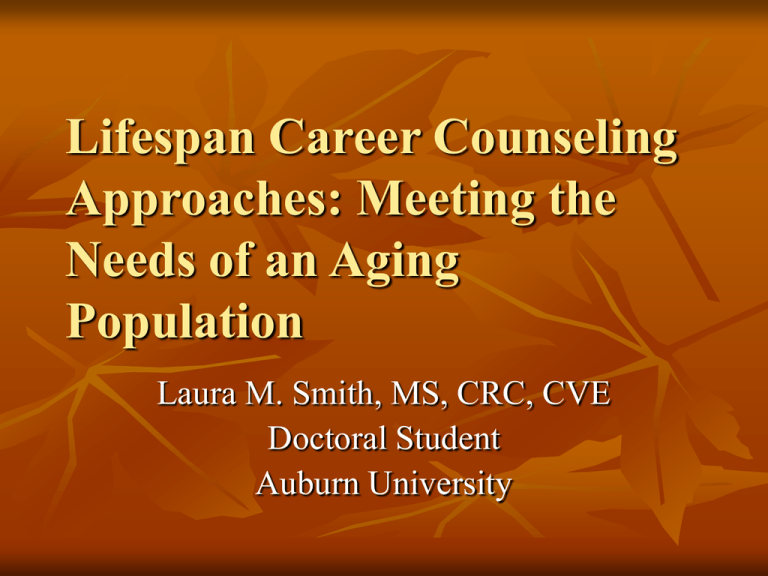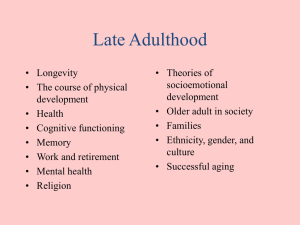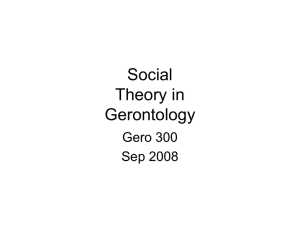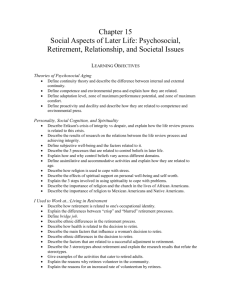Lifespan Career Counseling Approaches
advertisement

Lifespan Career Counseling Approaches: Meeting the Needs of an Aging Population Laura M. Smith, MS, CRC, CVE Doctoral Student Auburn University The Aging Workforce IRI PSG: Contemporary issue and challenge in the field of VR, 34th Institute, scheduled May, 2008 GAO Forum (12-5-2006): Engaging and Retaining Older Workers The Taskforce on the Aging of the American Workforce (DOL, May, 2006) Learner Objectives To review the unique characteristics and concerns of the mature worker in the context of fundamental changes in workplace and workforce To review lifespan career counseling approaches that are particularly effective for this population To focus on relevant VR issues including marketing and collaboration Overview Current and predicted trends for older workers Cultural and economic retirement incentives Older workers’ unique characteristics and concerns Lifespan counseling approaches Recommendations and ponderables “What’s Your Real Age?” Younger mature adult 40-62 Older mature adult 62+ Real Age complicated by disease and disability Senescence: period of decline until death; cells no longer reproduce; organs fail Statistics Currently 35 million people 65 and older 2011 first baby boomers will turn 65 2030 nearly 20% of the population is expected to be 65 or older “Demographic Tsunami” Aging boomers (1946-1964) Increased life expectancy/better health Post-boomer declining Birth Rates In the year 2025: Labor force decline Slow economic growth Slow federal revenue growth (GAO Forum, 2007) Life Expectancy/ Population Statistics 2003: a 65 year old male has an average life expectancy of 16.8 years; a 65 year old female has an average life expectancy of 19.8 years 12.4 % of the population—1 in 8– is an older American 2004: 18.1% of persons 65+ were minorities Income and Poverty Sources of income for mature adults include Social Security; assets; private and government employee pensions; earnings 3.6 million elderly persons (9.8%) below the poverty level in 2004 Poverty Guidelines $9,310 for a single individual (Federal Register, Vol. 69, No. 30, 2004.) 2.3 million (6.7%) “near poor” Older Worker Unemployment Subgroups for whom unemployment is persistent: Less educated Poorer health African American males 39% reduction in earnings in the two years following job loss Incentives to Retire Pension statutes and regulations: DB plans Employment Income Security Act (ERISA) Cultural expectations: Social Security NRA and early retirement age Mandatory retirement age (certain professions) Phased retirement not an option Age-Based Laws Age Discrimination in Employment Act (ADEA) and amendments (EEOC) Older Americans Act and amendments Perceptual, Cultural, and Legal Barriers to Work Age discrimination/employer perceptions Medicare Older worker perceptions Caregiving Managing chronic disease Laws Why Continue Working? Because older workers can! Downsizing Health coverage; ability to cover rising costs out of pocket Inadequate savings; income supplements Quality of life; maintenance of current lifestyle Intrinsic needs: social, productivity Employment as vocation The Value of Older Workers Experienced human capital/institutional knowledge Loyalty reflected in job tenure Low absentee and turnover rates Many willing to work part time or in contingent employment Physical Health Issues Age-onset disabilities include Hypertension (51%) Arthritis (48%) All types of heart disease (31%) Cancer (21%) Diabetes (16%) Sinusitis (14%) Mental Health Issues Cognitive functioning Depression (2-8% for older persons in communities; 10% in primary health settings; 15% in acute or nursing home settings) Depression as risk factor for disability Suicide rate Anxiety Disorders (11.4% community-residing adults) (Swett & Bishop, 2003) Substance Abuse Issues Pathways: early versus late onset Influences: cohort effects, socioeconomic status, frail health, discretionary income, status as a hidden population, caregiver complicity (Benshoff, Harrawood, & Koch, 2003) Family, caregiver, and clinician contribution to the abuse Transportation Issues Older driver safety Testing and drive remediation High and low technology Alternatives AARP Caregiving Issues Caring for aging parents Sandwich generation (triple-decker with grandchildren) Caregiving costs employers $11.7 to $29 billion per year in lost productivity (Metropolitan Life Insurance Company, 1997) Area Agencies on Aging (AAA) www.aoa.dhhs.gov/network.html Best Practices in Counseling Mature Adults Developmental career counseling approaches Transferability Health and financial literacy Training Career Counseling Theory Lifespan, life-space approach (Super) Career Development Stages: Growth, exploration, establishment, maintenance, disengagement Middle adulthood 45-65 Late adulthood over 65 Self-concept Career Adaptability Clarification of Vocational Identity Developmental, also known as thematicextrapolation method (Super) Client chronologies/life patterns Practical Applications Anticipate and prepare for change Process emotions associated with job loss, unemployment, transitions Select occupations congruent with interests and abilities: transferability Recycle through career stages Participate in lifelong learning (Brewington & Nassar-McMillan, 2000) Transferable Skills Skills used in one or more jobs that may be interchanged or substituted into another job Taking into account residual functional capacity (Weed and Field, 2001) Standard vocational evaluation method/tool; computer-based systems Soft Skills Soft skills: Motivation, getting along with coworkers, accepting supervision, getting to work on time, attending work regularly, giving notice of nonattendance, showing enthusiasm for improving one’s performance, requesting reasonable accommodations (Stensrud, 2007) Health Literacy Nine of 10 adults lack skills needed to manage health and prevent disease (U.S. Department of Health and Human Services, 2007) Numeracy skills Literacy skills Health knowledge 30 million people have below basic health literacy, describe health as poor, lack health insurance Financial and Benefits Issues Financial literacy Retirement budgeting Future health care costs The Training Imperative The value of training for older employees Environmental factors Employer attitudes Employee attitudes Discouraging training a subtle form of discrimination Training Guidelines Pace: Give extra time to complete training Provide relevance and hands on experience Build on informal and formal skills Self-directed and designed learning: software tutorials SeniorNet: http://www.seniornet.org/php/default.php?Page ID=6636 Recommendations Gerontology: the study of aging Gerontology threads within VR educational programs Gerontology coursework/specialty Interdisciplinary/interdepartmental gerontology coursework Social gerontologists Recommendations Advertising/social networking Consultation: business recruitment, selection, training, accommodation, and promotion processes (Stensrud, 2007) Attention to placement risk factors Partnerships: collaboration in service provision: DOL Protocol Future Trends Assistive technology Home modification (“Smart Homes”) and universal design Telehealth Managing chronic disease/disability management/employee retention Phased retirement Ponderables Will VR join in a national campaign to promote older workers? Will VR help to change the “culture of retirement” and national norms on “old age” and retirement? Will VR seek to form collaborative relationships with other agencies devoted to an aging population, and, if so, which ones? Structure and nature of relationship? Umbrella? Ponderables Continued What unique training and incentives can VR offer this population? Will VR be willing and able to accommodate a population who seeks part time, flexible hours? Will employers? Will VR be able to handle the transferability needs of counselors? Would within-unit vocational evaluators fill this need? Questions? References Email: smithl3@auburn.edu Website: www.auburn.edu/~smithl3/ Ms. Laura (“Mimi”) Smith Department of Rehabilitation and Special Education 1228 Haley Center Auburn University, AL 36849 (334) 844-3557




